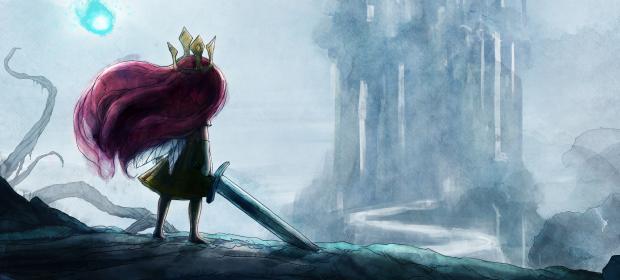There must be something in the water at Ubisoft at the moment. Not usually known for creating RPGs, they absolutely blew us away with South Park: The Stick of Truth, and Child of Light now follows suit, being yet another joyful experience that also looks wonderful from start to finish.
There’s something almost deceptive about that glorious UbiArt engine at first. Maybe it’s because it was previously seen in Rayman Legends, but for the first moments, you don’t realise you’re actually playing a deep RPG and not a platform game. There are elements of a platformer here, sure, and you are moving around an environment presented like a beautiful water-colour painting, but make no mistake: this is an RPG through and through (despite some rudimentary platform-based puzzles here and there), and as such is a lovely surprise.
But I can’t gloss over the visuals so quickly, because this is, without question, one of the prettiest games I’ve ever had the pleasure of playing. You’ve probably seen screenshots, maybe even videos, but nothing does the game justice like playing it in person. A breath of fresh air, the characters are rendered as though straight out of a Disney film, and there is never a single moment you won’t be in awe of how great it looks. Transitions between levels and areas are swift and there are barely enough loading screens to mention here, but each locale has a distinct visual flair to it, whether you are traversing a dark, underground lava cave, or a village full of mouse-people that has the hustle and bustle to match.
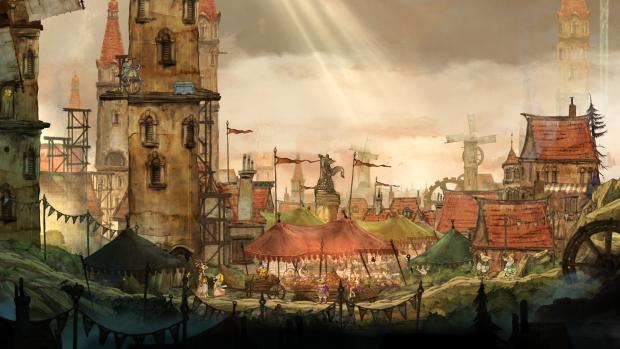
The audio is spectacular as well. There’s a theme to Child of Light that repeats throughout, but the orchestral accompaniment really matches the visuals well, touching on melancholia, desperation, and joy. Voice acting is used sparingly, as most of the dialogue is left for you to read, but when it does there are some odd pronunciation kinks, which is possibly in service of something wholly unique to Child of Light: everything rhymes.
I’m not just talking bits and bobs here, either – absolutely every piece of written text or spoken dialogue rhymes, apart from the descriptions in the menus. It’s tremendously amusing at times, and shows some bothersome writing at others, but it’s interesting nonetheless. Certain words are eschewed in favour of quirkier, less common terms, and whether the occasional instance of awkward wording irks you is purely down to personal preference, and while I liked it, it isn’t without fault.
On that note, the writing isn’t perfect, either. The story is a akin to a Disney princess tale, with you playing as Aurora, a young girl who is trying to save her dying father. In truth, there are some oddities in the narrative, and some blanks that are never quite filled in. For example, the story starts with Aurora falling asleep and finding herself in Lemuria (the place the entire game is set). Her father, stricken with grief, falls ill himself – and thus the tale turns on its head, with Aurora journeying to save herself, and Lemuria, along the way. Ultimately, however, the quest is to find celestial objects, and kill the bad guys. It becomes a rite of passage adventure, really, mostly dealing with themes of abandonment and loss, and although it’s presented in a very palatable manner, it’s hard not to feel for Aurora’s plight.
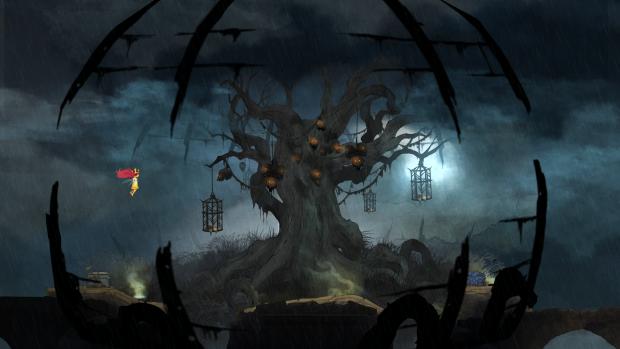
It’s well paced, and you’ll meet new characters (and party members) at regular intervals. The best thing about this is that despite there being no traditionally labelled class system, every single party member has personality, and brings something different to a battle. As the titular Child of Light, Aurora battles with a sword and light magic, obviously powerful against dark creatures. Other characters have various different skills: one late in the game is a veritable tank when it comes to physical attacks, but has no magic to speak of. Finn (the bearded chap seen in various screenshots) is the mage, and you’d be wise to spend his skill points quickly to get “lightning-all”, whereas other characters are primarily able to buff one another, or debuff the enemy.
This is all so vitally important, because the enemies are often elemental, and will use numerous irritating techniques such as slowing you down, speeding themselves up, shielding themselves, etc. In fact, Child of Light most reminds me of when the Final Fantasy series was great, and that’s a very good thing indeed.
The battle system is complicated to explain, but actually fairly intuitive and easy to get to grips with. On a very basic level, there are two stages to the turn-based active-time-battle on offer. There will be a bar on the bottom of the screen displaying which stage every character is at (enemies included). The blue section is the largest part, and this it the “wait” phase. During this stage you can plan what you intend to do, while also feeling the ramifications of previous turns, and what the enemy has done to you.
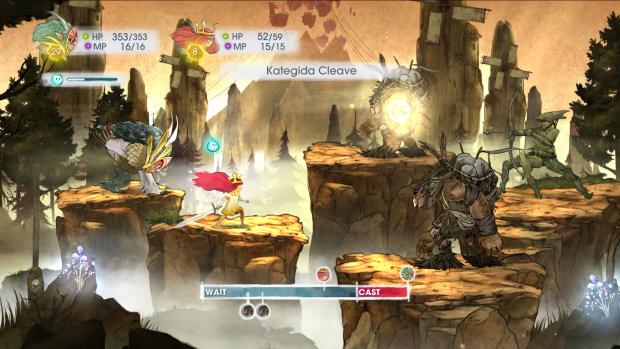
At the end of the wait period, you will stop at the “cast” phase. Here you can choose what you wish to do, be it defend (instantly) or attack. Each attack or magic-based skill has a casting period, varying from medium to very long – obviously the more powerful the skill, the longer it takes to cast. During the cast phase you can be interrupted if hit, which causes you to be set back to the waiting phase, which you (obviously) don’t want – but you can do the same to your enemy, so if you have a character who is particularly fast at casting their easiest attack, you can interrupt the enemy, even if you’re facing a boss.
If that doesn’t sound complicated enough, throughout your journey you have a glowing ball of light called Igniculus with you. Using the right analog stick, you move him around the environment and make him focus on enemies by holding the trigger, which slows down their timeline. This adds immensely to the tactical nature of the battles, giving you more than one thing to focus on at any given time. Maybe if you slow down that boss enough, your slower caster can get their spell out without interruption. You can also heal your party by focusing on them, but of course doing this means you’re not slowing the enemy. Igniculus also has a finite amount of energy, refillable by hovering over flowers during the battle (or in the outside world, too). These replenish during the really long fights, but it’s still worth keeping an eye on that energy bar.
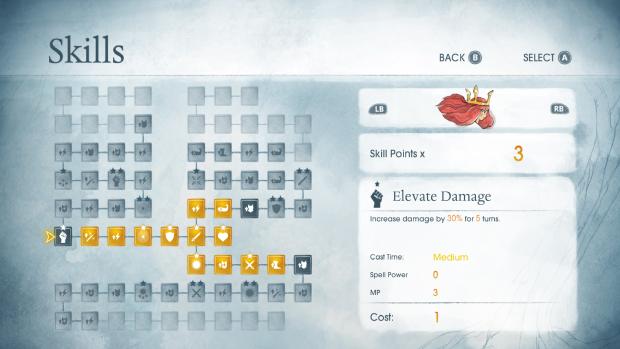
Out in the overworld, Igniculus can get to areas Aurora cannot, and there are numerous chests and collectibles that he is invaluable in finding. There are a decent amount of side-quests on offer too, some of which are obvious, and a few which are slightly more obtuse – in fact, some are hindered by the rhyming structure. It’s worth mentioning that Child of Light can be played co-operatively, with the second player controlling Igniculus, which is a lovely way to play with a friend, or perhaps even aimed at getting younger gamers involved. Solo players on PlayStation 4 can use the touchpad as a mouse, with a click of the pad holding the focus but, in honesty, I found the stick to be the easier way to control things.
Elsewhere, there are skill trees for every single character, with each offering three routes. By the time I’d completed Child of Light I had every character at around level 47, with about 75% of their skill trees completed. You’ll level up an awful lot after you get into the game, and thankfully even if not used in a battle, other party members will still level up. There are also collectible items that immediately add points to specific stats: health, strength, magic defence, etc.
You don’t have to worry about weapons, but there is a crafting system called Oculi. Each character has three Oculi slots, all of which buff them in some way. Three of the same Oculi crafted together will level it up, until you are creating “brilliant” versions of them. A brilliant diamond is a must-have, as it will buff your XP by a high percentage each battle, whereas others add fire damage. Take that same Oculi that adds fire damage and put it in another slot and it will instead add fire protection – it’s that kind of system. It’s oddly satisfying to notice that you now suddenly have the three requisite coloured Oculi to make a diamond one, before suddenly falling down a small rabbit hole and crafting lots of better ones, and re-equipping them.
It’s all wonderfully deep, and, to be frank, excellent. But it’s not all perfect. For starters, it’s far too easy. I never saw a Game Over sign once during the entire playthrough, and in fact, I only ever had to revive a character in battle four times. There’s a hard mode, of course, and I’d recommend that seasoned RPG fans make use of that from the start. Also, the enemy design is rather lacklustre. Spiders, winged beasts, ghostly apparitions and the like are everywhere in the open world. You can actually ignore a lot of them, but to fight them you can approach from behind to get a surprise first attack, though they can do the same. The problem is that there’s not enough variation. Having a spider glow red and be on fire (because he’s a fire-element spider, so, you know, use water against him) is about as varied as it gets. Even the bosses are very similar in nature, aside a few.
Though there were moments where I feared Child of Light would outstay its welcome, it is just the right length, wrapping up inside a cool 12-15 hours and allowing you to go back after the credits roll to mop up any side quests or max out your skill trees. One word of caution, mind, is that it funnels you into the end game fairly suddenly. After the mid-point, the goal becomes clearer, and you know exactly how many story bosses there are left to fight. The last two happen in quick succession, so know that if you are about to go after the penultimate boss, you’re going to see the credits roll before you can go back and explore.
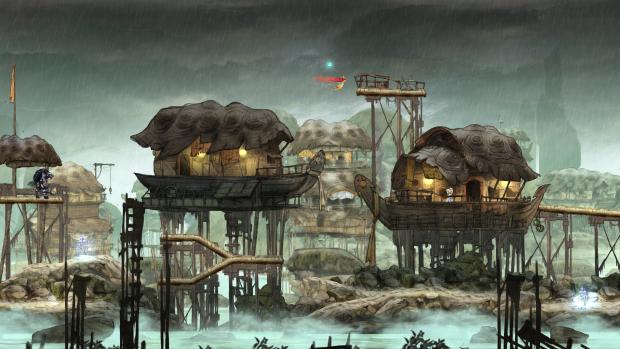
VERDICT: It’s so pleasing to see a game this gorgeous actually back that up with impressive gameplay, as long as you’re a fan of the genre, that is. An impressively deep RPG that actually bothers to make each party member feel different in combat, while telling a story that most will relate to in some way or another, Child of Light is full of whimsy, yet also full of heart and never gets boring.
Although it’s a bit too easy, and doesn’t offer very much post-game content, this is a surprisingly brilliant game that tries something new and succeeds way more often than it fails. Child of Light is full of character and personality, and is probably one of the best looking games you’ll play this year, relying on design instead of power. Give it a go, you’ll find it very hard not to fall in love with Aurora’s tale, and the land of Lemuria.

SUPERB. This is the mark of greatness, only awarded to games that engage us from start to finish. Titles that score 9/10 will have very few problems or negative issues, and will deliver high quality and value for money across all aspects of their design.


